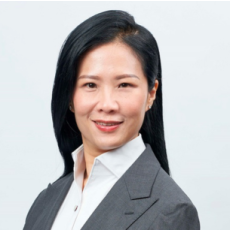The Singapore Economic Development Board (EDB) is a government agency responsible for strategies that enhance Singapore’s position as a global centre for business, innovation, and talent. EDB undertakes investment promotion and industry development in the manufacturing and internationally tradable services sectors, including aerospace.
You've been at the Singapore EDB for over 20 years now. How much has Singapore's presence in the aerospace industry evolved and grown in that time?
Singapore has one of Asia’s largest and most diverse aerospace ecosystems. The growth of our aerospace industry has been tied to Singapore's development as a global aviation hub. Changi Airport was opened in 1981. We benefited from the rise in air travel and our strategic location as a gateway to Southeast Asia. To accommodate the growing demand for air travel, we continued to invest in our infrastructure and began air freighting high-value goods to global markets. Soon, Singapore became a leading aviation hub for both air cargo and passenger traffic.
This led to the establishment of numerous maintenance, repair, and overhaul (MRO) activities, and over time, Singapore made great progress in anchoring MRO and manufacturing activities of mission-critical components to serve regional and global markets. Today, Singapore counts about 130 globally leading MNCs and local enterprises within our aerospace ecosystem. We contribute about 10% of global MRO output and are confident of the industry’s long-term outlook. The global MRO market is expected to grow more than 33% between 2023 and 2033. Asia-Pacific, in particular, with its expanding economies and rising middle class, is expected to be a strong driver of growth.
Did the growth of Singapore’s aerospace industry happen gradually, or were there moments over the past 20 years when it intensified at all?
Singapore’s aerospace industry has evolved from the maintenance of aircraft and other general aviation activities to performing MRO and manufacturing critical and high-value components such as engine components and avionics. Aerospace companies have also established other key activities here, including regional headquarters, regional distribution centres and flight training facilities, tapping into our connectivity and infrastructure.
At the same time, our skilled workforce, strong IP protection and robust research ecosystem have attracted global players to strengthen and expand their operations here. For example, in 2001, Rolls-Royce established its joint venture with SIA Engineering Company (SIAEC) to perform MRO activities. Rolls-Royce has since expanded its activities to include manufacturing and innovation.
Singapore hosts around 130 aerospace companies. What does that international versus local spread look like?
We have a mix of global players and local enterprises. Partnerships between international firms and our local champions like SIAEC and ST Engineering Aerospace play a crucial role in developing our aerospace ecosystem.
For example, these partnerships have enabled Singapore to host MRO activities for engine platforms across all four major engine OEMs: CFM International, GE Aerospace, Pratt & Whitney, and Rolls-Royce. We also support local SMEs in building capabilities to work alongside these major players.
Cast your mind back to 2020. How severe has the impact of the pandemic been on the aerospace industry in Singapore?
The pandemic caused an industry downturn globally and our workers and businesses were affected. But in anticipation of an eventual recovery, we made it a priority to retain skilled workers. The government introduced the Job Support Scheme (JSS) to prevent retrenchments and upskill employees. We also looked for opportunities to retrain workers for adjacent industries to keep them employed and maintain their skills.
While there were employees who left the industry during the pandemic, companies ramped up hiring with the recovery in air traffic. By 2023, our aerospace employment of 21,000 was close to pre-pandemic levels, while our aerospace output had exceeded pre-pandemic levels by almost 20 per cent. Companies here are growing and hiring aggressively, and the government is working with companies and partners to develop a strong talent pipeline. For those nearing retirement, we are working with companies on re-employment options, given their valuable experience and wealth of knowledge. For younger employees, the focus is on training and upskilling.
How do you account for Singapore's unique geography and subsequent resource limitations while pursuing sustainability and net zero emission targets?
Our size and physical constraints have always been challenges but these have not precluded us from pursuing sustainable development. To help businesses operate more sustainably, we are working to increase their access to renewable energy. Current renewable energy deployment in Singapore includes solarising as much land, rooftops, or even water bodies as possible.
To further bolster our access to renewable energy, we are working with neighbouring countries to import renewable energy. By 2035, we plan to import 4.2 gigawatts of green electricity, which will be about 30% of our energy needs.
Singapore is home to the largest bio-refinery producing sustainable aviation fuel (SAF) in the world, owned and operated by Finnish company Neste. Neste’s Singapore Refinery produces up to 1 million tons of SAF per annum, serving the domestic and international markets. To further catalyse demand, we have published a Sustainable Air Hub Blueprint with a target for flights departing Singapore to use 1% SAF by 2026, supported by a levy on air travel. We aim to increase this to 3-5% by 2030 depending on global developments and SAF demand.
Singapore has a unique model with industry, government, and academia working closely together. How has this setup impacted the adoption of new technologies?
Singapore's model involves government, academia, and industry working alongside each other to conduct research and enable the adoption of new technologies. Innovation efforts in the aerospace sector span different technology readiness levels (TRLs), from upstream research to commercial deployment. For example, the collaboration between A*STAR, Rolls-Royce, and Singapore Aero Engine Services Pte Ltd (SAESL), which focuses on high TRL areas, has resulted in S$6 million in total cost savings to date for the companies through deploying advanced manufacturing and predictive maintenance technologies.
In low TRL areas, we invest in R&D for future technologies, like aircraft electrification. The biennial Singapore Airshow's Technology Leadership Forum, held in conjunction with the Singapore Airshow, brings together global aerospace CTOs and CSOs to discuss technological challenges and opportunities. This helps us align our funding and research efforts with industry needs, ensuring Singapore remains at the forefront of aerospace innovation and a catalyst for industry collaboration.





